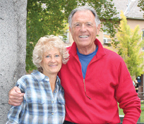 |
| Lori Curtis and Lex Blood |
Préface
The idea for this website and book came from the fertile minds of the Flathead Community of Resource Educators (CORE) Watershed Education Committee members. The committee identified a need for a resource that would communicate basic information about the ecological and cultural depth of the watershed. The sourcebook would be historical, scientific, and approachable. But it was the synergy of interests between Flathead community educator Lex Blood and author Lori Curtis that brought it to fruition.
|
The steering committee and the author are pleased to present this site and this second edition of the Flathead Watershed Sourcebook: A Guide to an Extraordinary Place. Given the complexity of the natural and human history of the watershed, this project does not—could not—cover every topic in detail. Rather it is a “primer” on the watershed, an introduction to the history, places, people, and resources that make the Flathead Watershed so exceptional. The watershed’s grandness is evidenced by the number and diversity of people who have contributed content, funding, time, or expertise to the making of the book and website. Globally, multidisciplinary groups are forming political, cultural, and environmental views based on bioregions. Bioregions are areas defined by physical and environmental features such as watershed boundaries. But bioregional practice stresses the importance of local populations, knowledge, and methodologies in the determination of a bioregion. Over the years, this thinking has contributed to improving the way we manage our resources. The Flathead Watershed bioregion is rich in cultural and ecological resources. People have inhabited the Flathead Watershed continuously since the end of the last Ice Age. The rocks around us tell the stories of glaciations and carving of features between 10,000 and 2 million years ago, overthrusting and sedimentary deposition between 2 and 65 million years ago, and mountain building and an abundance of life forms 65 to 225 million years ago. Today, the Flathead Watershed remains one of the most diverse aquatic and terrestrial bioregions in North America. It is indeed extraordinary. |
Steering Committee from left to right - Robin Steinkraus: Executive Director, Flathead Lakers; Patti Mason: Outreach & Watershed Coordinator, Flathead Conservation District; Mike Koopal: Founder & Executive Director, Whitefish Lake Institute; Lori Curtis: Author, eBizServices; Lex Blood: Founder, Crown of the Continent Ecosystem Education Consortium; Nancy Zapotocki, Conservation Educator, Flathead Audubon Society; Teresa Wenum: Conservation Education Specialist, Flathead National Forest. Not pictured - Caryn Miske: Executive Director, Flathead Basin Commission. With “Fish Spirit Place”, a centennial sculpture by Bigfork artist Jeffrey Funk.
Source: Walt Curtis |
Our hope is that this project will help communicate some of the history of the watershed known best by Tribal Elders whose history goes back for millennia and old-timers whose families have inhabited and worked the land for multiple generations. We believe it presents a peek into the geology and biodiversity of the place. We hope it will offer newcomers a compelling glimpse into the life-place of the Flathead Watershed.
Professor Emeritus of Landscape Architecture Robert L. Thayer, Jr. wrote, “Life-place culture, I think, is not a concept to be grasped hard by a tightly clenched fist; rather, it must be held lightly and balanced in the palm of an open hand. It also requires the joining of many hands—the active engagement of student hands raised in question, of clasped hands around shovels, of cradled hands around new seedlings, of hands shaking in agreement, of hands patting people on the back, of hands raised in celebration.”
The collective efforts of this work have resulted in a central source of information& (printed and electronic) about the Flathead Watershed. We hope it will engage citizens to understand and care for their watershed while encouraging them to develop their own sense of place. We look forward to the book and website being used by educators to accomplish their diverse watershed education goals. And, we hope we have communicated, through many voices, the splendor and fragility of the Flathead Watershed.

